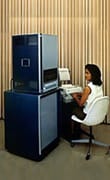|
In late 1966, the research vessel "Chain" departed Woods Hole Oceanographic
Institution in Massachusetts with a little extra weight on
board. Along with its customary cadre of scientists, marine
experts, technical staff and sea crew, the vessel carried some
unusual cargo—HP's first computer, the 2116A.

|
| HP entered the computer market in 1966 with the invention of the HP 2116A. |
| |
In the mid-1960s, customers needed a machine to computerize
instrument systems—at a price range most users could afford.
However, the consensus in the industry at the time was that
computers were not broadly compatible with instruments and
required significant additional hardware and software support
to boot.
HP rose to the challenge. The collaboration of several
divisions, including former Data Systems engineers and HP Labs
and Dymec employees, resulted in the HP 2116A's public
unveiling at the 1966 Joint Computer Conference in San
Francisco.
The 2116A was the largest single
mechanical package HP had ever built. It marked HP's first use
of the integrated circuit and the development of a FORTRAN
compiler and associated software. In addition, a number of
standard laboratory instruments could interface with the HP
2116A such as electronic counters, nuclear scalers, electronic
thermometers, digital voltmeters and input scanners.
"What is really different about the HP computer," said Noel
Eldred in 1966, then HP marketing vice president, "is that it
will save thousands of dollars and months of time for the user
who wants to computerize his instrument system."
As the company's MEASURE magazine reported in 1967, two other
aspects of the 2116A were considered ahead of its time. First,
the hardware was developed much more rapidly than the industry
average for similarly complex systems. Second, the software
was made available simultaneously with the hardware—a rare
accomplishment at the time.
Through
the tireless efforts of HP employees Kay Magleby, Ed Holland,
Arne Bergh, Willie Austin and many others, ruggedness and
reliability became hallmarks of the 2116A. HP's "go-anywhere,
do-anything" computer was eventually discontinued as new
technologies rendered the 2116A obsolete. However, for nearly
a decade, Woods Hole Oceanographic Institute successfully used
the HP workhorse to record data under harsh sea conditions.
|

